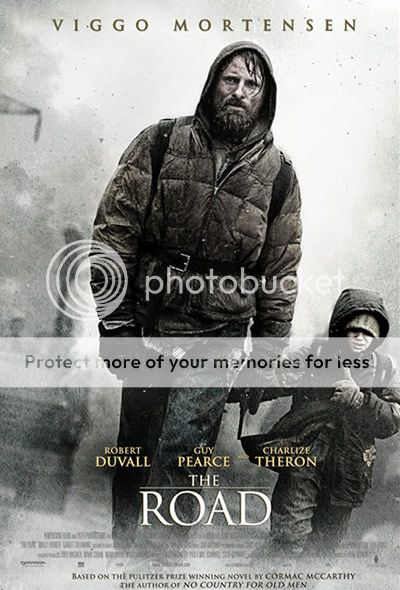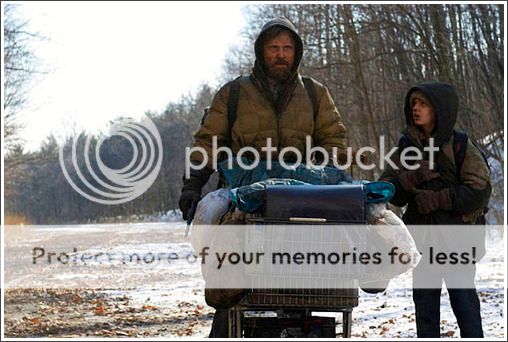
Remember back in high school, when you’d skirt having to read the book by watching the movie instead, and your teacher would admonish you for not getting the most out of the experience? I never fully grasped what that meant until watching The Road, a new feature film adaptation of Cormac McCarthy’s Pulitzer Prize-winning survival epic. Though dedicated to realizing McCarthy’s scope of a ruined, uninhabitable planet and is a pleasant enough watch, the film ultimately can’t translate the book’s introspective vision and humanistic totality. Sometimes, it’s better sticking with
the 1,000 words. Complete ScriptPhD.com review under the “continue reading” jump.
Review: The Road
ScriptPhD Grade: B
The blackness he woke to on those nights was sightless and impenetrable. A blackness to hurt your ears with listening. Often he had to get up. No sound but the wind in the bare and blackened trees. He rose and stood tottering in that cold autistic dark with his arms outheld for balance while the vestibular claculations in his skull cranked out their reckonings.
-Cormac McCarthy, The Road
The Road is not a pick-me-upper by any means. Raw in its bleakness, unforgiving in its brutality, it is a lugubrious tale of a nameless father and son’s journey across a ghostly post-apocalyptic landscape devastated by an indeterminate holocaust. Knowing they won’t survive another winter in their current habitat, and with only each other, their memories, and a shopping cart of possessions to rely on, the two “carry the fire” along a road, both literal and existential, down the coast towards the Southern shore. Dying of starvation, yet refusing to give in to the cannibalism and savagery around them, the boy and his father, referring to themselves as “the good guys”, battle ungodly conditions, filth, an onslaught of “bad guys”, and their own demons in search of some kind of freedom and hope amidst a scorched earth. While minimizing some of the more barbaric imagery within the novel (a human infant roasting on a spit, tunnels piled high with human carcasses, mummies everywhere), the film adaptation, starring Viggo Mortensen as The Man and Kodi Smit-McPhee as The Boy, is no less dreary. If anything, The Road on screen seems to bypass the few glimmers offered in the novel for a road that goes on forever and leads to nowhere.
Director John Hillcoat and his team of art directors used masterful lighting and set design to evoke the omnipresent grays and ashen hues of the book. The landscapes of Oregon and Pennsylvania, with fires raging, dilapidated old grocery stores and highways, blackened tree stumps, become a living character of the film. Screenwriter Joe Penhall wisely crafts the film’s narrative directly from McCarthy’s sparse dialogue (mostly word for word) and voice overs of critical plot points. While Mortensen turns in an average performance and does what he can with the given material, Smit-McPhee’s precocious portrayal of The Boy as his father’s moral center is easily the film’s highlight. Charlize Theron’s role as the deceased mother, told retroactively in flashbacks, is somewhat plumped up from bare mentions in the book. In most ways, the film is a perfectly fine, by-the-numbers retelling of the story. So what’s missing in this interpretation? Spirituality and most importantly, hope.

Presenting a classic good versus evil fable, The Road is littered with Biblical imagery, symbolic and direct. The boy bathing in a waterfall takes on the feel of a baptism of sorts. Serpents burning alive are “no remedy for evil but only for the image of it as they conceived it to be.” The boy himself embodies a Christ-like figure in the book, a corporeal symbol of a second coming for humanity. His hair is a “golden chalice, good to house a god.” His prophetic dreams, a major driver of the journey and foreshadowing of his father’s death, are not featured in the film. An encounter on the road with a blind old man, Ely (in the Old Testament, Elijah is a harbinger of the Messiah’s second coming) is a critical point in the story. In the book, when the old man suggests that “there is no God and we are his prophets,” the father offers his son as a god. In the film, the old man (a barely recognizable Robert Duvall) feels presented as a plot device to highlight the boy’s inherent goodness, but no more than that. Likewise, in the wake of such overwhelming tragedy, the book manages to elicit unlikely moments of hopefulness that just didn’t translate in this gloomy adaptation. A flare gun used to kill a desperate thief is also presented in the book as a greeting to God or whoever is left. While rummaging for supplies on an abandoned ship, a preserved brass sextant appears as a glimmer of beauty, of the possible. With such gorgeous visual possibilities, and deft imagery to paint an impossibly devastated world, it would have been nice for the final image of the book—fish swimming in a stream—to leave moviegoers with a similarly uplifting note.
In 2008, The UK Guardian named Cormac McCarthy one of 50 People Who Could Save the Planet, calling The Road “the most important environmental book ever.” (One could make a case for Rachel Carson’s Silent Spring.) The film will undoubtedly also be toted in such laudatory fashion as a paragon of environmental heed. To do so is to misrepresent this story’s true intent. In a recent, candid interview with The Wall Street Journal, Cormac McCarthy was asked whether director John Hillcoat pressed him on the exact cause of the apocalypse. Said McCarthy: “A lot of people ask me. I don’t have an opinion. At the Santa Fe Institute I’m with scientists of all disciplines, and some of them in geology said it looked like a meteor to them. But it could be anything—volcanic activity or it could be nuclear war. It is not really important. The whole thing now is, what do you do? The last time the caldera in Yellowstone blew, the entire North American continent was under about a foot of ash. People who’ve gone diving in Yellowstone Lake say that there is a bulge in the floor that is now about 100 feet high and the whole thing is just sort of pulsing. From different people you get different answers, but it could go in another three to four thousand years or it could go on Thursday. No one knows.”
Ultimately, the production and writing team behind The Road put in a valiant effort to extrapolate the book’s staples to a largely faithful, if rote, film adaptation, but failed to elevate to the same depth and hints of beauty in despair. How can you transpose the soul of McCarthy’s exposition—an exposition so rich in imagery and spiritual context, so universal in theme, so profound in meaning—to a direct visual medium?
A dead swamp. Dead trees standing out of the gray water trailing gray and relic hagmoss. The silky spills of ash against the curbing. He stood leaning on the gritty concrete rail. Perhaps in the world’s destruction it would be possible at last to see how it was made. Oceans, mountains. The ponderous counterspectacle of things ceasing to be. The sweeping waste, hydroptic and coldly secular. The silence.
You can’t.
View an exclusive Apple featurette on the making of The Road here.
Trailer:
The Road is out in theatres nationwide on Wednesday, November 25, 2010.
~*ScriptPhD*~
*****************
ScriptPhD.com covers science and technology in entertainment, media and pop culture. Follow us on Twitter and our Facebook fan page. Subscribe to free email notifications of new posts on our home page.